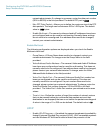
Configuring the PVC2300 and WVC2300 Cameras
Setup > Basic Setup
Cisco PVC2300 and WVC2300 Internet Video Cameras with Audio Administration Guide 47
8
• Authentication—Select the appropriate authentication type used on the
wireless network.
WPA /WPA2 Personal
This security mode option offers two encryption methods, TKIP and AES, with
dynamic encryption keys. Enter the Shared Key, which can have 8 to 63
characters. Then enter the Key Renewal Timeout, which instructs the device how
often it should change the encryption keys.
• Encryption—This cannot be modified.
• Shared Key—Enter the shared key used for accessing the wireless
network.
WPA /WPA2 Enterprise
WPA2 Enterprise requires some advanced expertise because it involves setting
up a RADIUS server for authentication and, in some cases, creation of certificates
for both the RADIUS server and the camera.
If you are using WPA/WPA2 Enterprise security, you will need to upload security
certificates to the camera. Certificates must be in the following format:
• Root certificate: DER encoded binary x.509 (CER/PEM)
• User certificate: Personal Information Exchange (PKCS#12 (.PFX))
The configuration options for this security mode vary depending upon the
protocol type selected.
• Protocol Type—Select EAP-TLS or EAP-TTLS.
EAP-TLS
With EAP-TLS you enter the user ID and password for the RADIUS server and
choose where the camera should check for the server and user certificate.
WAP/WPA2 Enterprise (EAP-TLS)
• User ID—User ID is used to login to your RADIUS server.
• Root CA—A root certificate is an unsigned public key certificate, or a self-
signed certificate, which implies that you trust your browser’s publisher to
include correct root certificates and in turn the certificate authorities it
trusts, and anyone to whom the CA may have issued a certificate-issuing-
certificate, to faithfully authenticate the users of all their certificates.


















